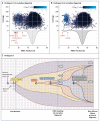Clonal hematopoiesis and blood-cancer risk inferred from blood DNA sequence
- PMID: 25426838
- PMCID: PMC4290021
- DOI: 10.1056/NEJMoa1409405
Clonal hematopoiesis and blood-cancer risk inferred from blood DNA sequence
Abstract
Background: Cancers arise from multiple acquired mutations, which presumably occur over many years. Early stages in cancer development might be present years before cancers become clinically apparent.
Methods: We analyzed data from whole-exome sequencing of DNA in peripheral-blood cells from 12,380 persons, unselected for cancer or hematologic phenotypes. We identified somatic mutations on the basis of unusual allelic fractions. We used data from Swedish national patient registers to follow health outcomes for 2 to 7 years after DNA sampling.
Results: Clonal hematopoiesis with somatic mutations was observed in 10% of persons older than 65 years of age but in only 1% of those younger than 50 years of age. Detectable clonal expansions most frequently involved somatic mutations in three genes (DNMT3A, ASXL1, and TET2) that have previously been implicated in hematologic cancers. Clonal hematopoiesis was a strong risk factor for subsequent hematologic cancer (hazard ratio, 12.9; 95% confidence interval, 5.8 to 28.7). Approximately 42% of hematologic cancers in this cohort arose in persons who had clonality at the time of DNA sampling, more than 6 months before a first diagnosis of cancer. Analysis of bone marrow-biopsy specimens obtained from two patients at the time of diagnosis of acute myeloid leukemia revealed that their cancers arose from the earlier clones.
Conclusions: Clonal hematopoiesis with somatic mutations is readily detected by means of DNA sequencing, is increasingly common as people age, and is associated with increased risks of hematologic cancer and death. A subset of the genes that are mutated in patients with myeloid cancers is frequently mutated in apparently healthy persons; these mutations may represent characteristic early events in the development of hematologic cancers. (Funded by the National Human Genome Research Institute and others.).
Figures




Comment in
-
Clone wars--the emergence of neoplastic blood-cell clones with aging.N Engl J Med. 2014 Dec 25;371(26):2523-5. doi: 10.1056/NEJMe1412902. Epub 2014 Nov 26. N Engl J Med. 2014. PMID: 25426835 No abstract available.
-
Human genetics: somatic mutations linked to future disease risk.Nat Rev Genet. 2015 Feb;16(2):69. doi: 10.1038/nrg3889. Epub 2014 Dec 23. Nat Rev Genet. 2015. PMID: 25534323 No abstract available.
-
Clonal hematopoiesis and blood-cancer risk.N Engl J Med. 2015 Mar 12;372(11):1071-2. doi: 10.1056/NEJMc1500684. N Engl J Med. 2015. PMID: 25760361 No abstract available.
-
Clonal hematopoiesis and blood-cancer risk.N Engl J Med. 2015 Mar 12;372(11):1071. doi: 10.1056/NEJMc1500684. N Engl J Med. 2015. PMID: 25760362 No abstract available.
Similar articles
-
Age-related clonal hematopoiesis associated with adverse outcomes.N Engl J Med. 2014 Dec 25;371(26):2488-98. doi: 10.1056/NEJMoa1408617. Epub 2014 Nov 26. N Engl J Med. 2014. PMID: 25426837 Free PMC article.
-
Clonal Hematopoiesis and Risk of Atherosclerotic Cardiovascular Disease.N Engl J Med. 2017 Jul 13;377(2):111-121. doi: 10.1056/NEJMoa1701719. Epub 2017 Jun 21. N Engl J Med. 2017. PMID: 28636844 Free PMC article.
-
Clonal hematopoiesis and blood-cancer risk.N Engl J Med. 2015 Mar 12;372(11):1071. doi: 10.1056/NEJMc1500684. N Engl J Med. 2015. PMID: 25760362 No abstract available.
-
Clonal hematopoiesis in human aging and disease.Science. 2019 Nov 1;366(6465):eaan4673. doi: 10.1126/science.aan4673. Science. 2019. PMID: 31672865 Free PMC article. Review.
-
[Aging and clonal hematopoesis.].Adv Gerontol. 2024;37(3):266-275. Adv Gerontol. 2024. PMID: 39139119 Review. Russian.
Cited by
-
Clonal dynamics after allogeneic haematopoietic cell transplantation.Nature. 2024 Oct 30. doi: 10.1038/s41586-024-08128-y. Online ahead of print. Nature. 2024. PMID: 39478227
-
The Comparative Effect of Plasma Exosomes of Young and Old People on the Expression of BCL-2 and BAX Genes in Hematopoietic Stem Cells.Indian J Hematol Blood Transfus. 2024 Oct;40(4):647-654. doi: 10.1007/s12288-024-01779-x. Epub 2024 May 1. Indian J Hematol Blood Transfus. 2024. PMID: 39469166
-
Clonal hematopoiesis in cardiovascular aging: Insights from the verona heart study.Geroscience. 2024 Oct 26. doi: 10.1007/s11357-024-01367-x. Online ahead of print. Geroscience. 2024. PMID: 39460851
-
Mechanisms of Germline Stem Cell Competition across Species.Life (Basel). 2024 Oct 1;14(10):1251. doi: 10.3390/life14101251. Life (Basel). 2024. PMID: 39459551 Free PMC article. Review.
-
Age-associated imbalance in immune cell regeneration varies across individuals and arises from a distinct subset of stem cells.Cell Mol Immunol. 2024 Oct 24. doi: 10.1038/s41423-024-01225-y. Online ahead of print. Cell Mol Immunol. 2024. PMID: 39443746
References
-
- Nowell PC. The clonal evolution of tumor cell populations. Science. 1976;194:23–8. - PubMed
-
- Reya T, Morrison SJ, Clarke MF, Weissman IL. Stem cells, cancer, and cancer stem cells. Nature. 2001;414:105–11. - PubMed
-
- Jaiswal S, Ebert BL. MDS is a stem cell disorder after all. Cancer Cell. 2014;25:713–4. - PubMed
-
- Potter NE, Greaves M. Cancer: persistence of leukaemic ancestors. Nature. 2014;506:300–1. - PubMed
Publication types
MeSH terms
Grants and funding
LinkOut - more resources
Full Text Sources
Other Literature Sources
Medical
